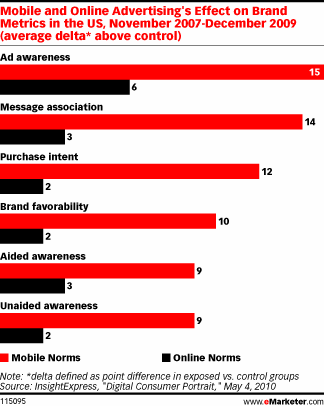The US mobile advertising market is expected to reach $593 billion this year according to eMarketer, and that growth is attributed to research which demonstrates high response rates and positive branding from mobile ads. In fact, research from InsightExpress reports that mobile ads are “significantly more effective than online ads across several branding metrics … exposure to mobile ads provided two and a half times the lift of online ads for ad awareness and six times the lift in purchase intent.” Now, those are statistics that are hard to ignore.
Take a look at the chart from eMarketer below which shows specifically how mobile vs. online advertising affected respondents’ impression of brands.

In terms of click-through rates, the most avid mobile device users (typically smartphone owners) were most likely to click on mobile banner ads but found full-page ads intrusive and clicked on them far less often. Also interesting was the finding that claimed less avid mobile users noticed sponsored apps more often and clicked on them more often than avid mobile users.
As I wrote about last month, Fortune 500 corporate executives are less enthusiastic about mobile advertising, but it would appear based on these statistics that they might want to re-evaluate. Clearly, mobile ads are getting noticed and having a positive effect, not to mention getting the click-throughs that executives value so highly.
The trick now is figuring out which types of mobile advertising generate the most positive responses from specific target audiences. The InsightExpress research found a variance between how different ads perform, from mobile video ads to mobile Internet ads and more, in terms of purchase intent, awareness, and brand favorability. For example, mobile Internet ads saw the biggest increase in ad awareness and purchase intent but mobile video ads saw the biggest increase in brand favorability.
Mobile advertising is still in its infancy and no path for success has been defined yet. We’re still very much in the experimentation and learning phase, but if your brand isn’t there experimenting and learning, you’re missing out on a big opportunity that your competitor just might cash in on before you can get budget approval. In other words, the time to add a mobile component to your marketing plan is now.
Your thoughts?
Lucy is Editor at Corporate Eye


